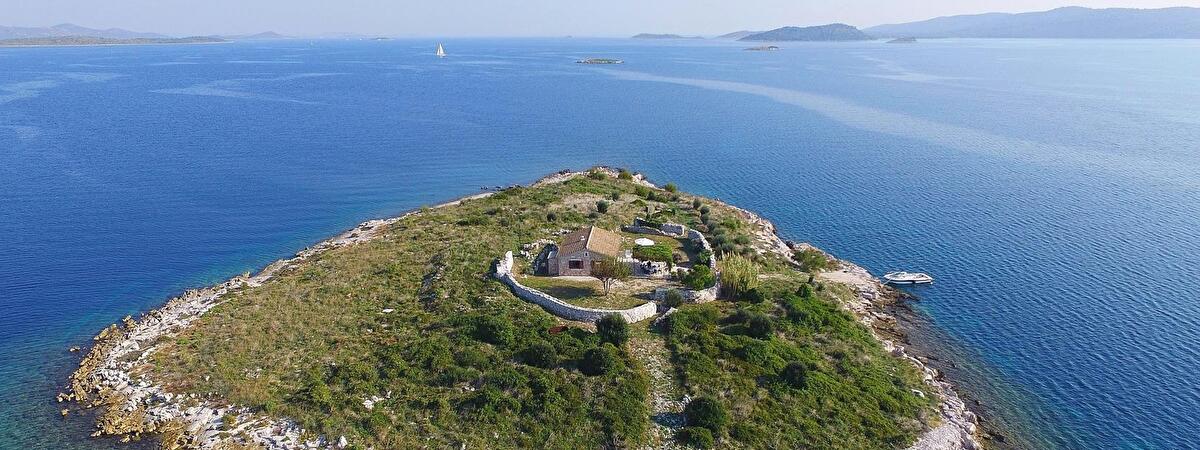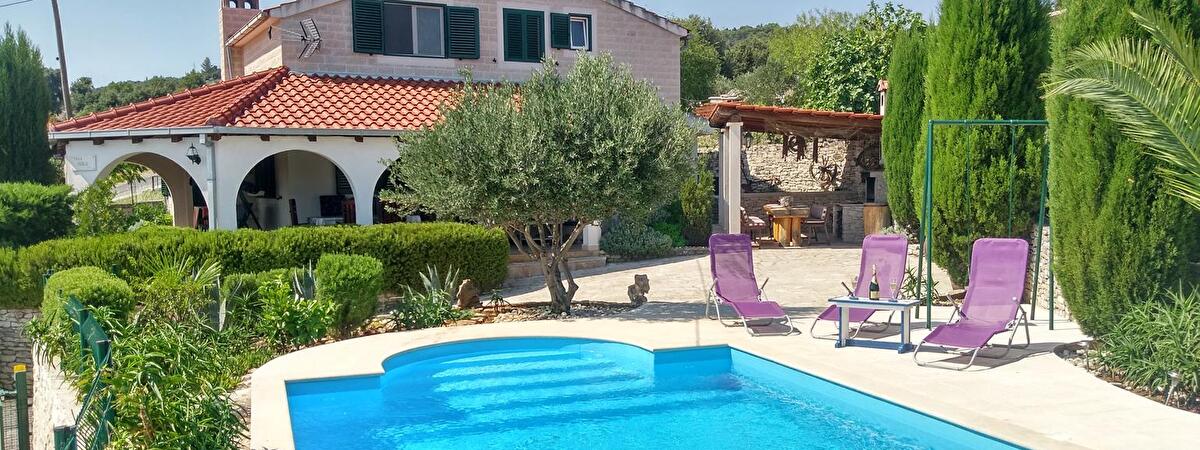Island Hvar
Its mild climate and varied tourist offer makes it a favorite destination for all seasons.
Access to the island Hvar
Hvar is an island in central Dalmatia, in the region of Split.
- It is accessed from Split (2:00 ferry or faster pedestrian catamaran) to Stari Grad west
- or further down the coast from Drvenik (35 minute ferry ride) to Sucuraj at the east end.
General summary
.JPG)
A beach in Zavala
Hvar is one of the most visited islands in the Mediterranean, one of the largest in Dalmatia and the sunniest destination in Croatia. Hvar enchants with its beauty, its scents of the sea, herbs and lavender.
A main road across the island in all its length (about 75 km) through authentic farming villages, lavender fields and olive groves, green forests and vineyards.
Some secondary roads down to the sea and its many coves inhabited sometimes, sometimes isolated, always beautiful. The island offers a wide range of sporting activities with of course all water sports but also interesting bike tours.
Cultural activities are present in the summer all the cities and the riches of the land subject to traditional events: festival lavender, evening fish, wine festivals, etc.
Arrival in Stari Grad on the north west is the oldest town on the island and Croatia. Built at the bottom of a deep and sheltered bay, it has always been very popular browsers. Its fertile plain is planted since ancient vineyards and olive groves and is surrounded by pine forests. The old part of the city was spared, with its narrow streets with stone houses, churches and many cultural monuments, it is very pleasant to walk.
Become a modern tourist center with many cultural and sporting events are held here in summer: festivals, concerts, shows, marathon swimming ... It is a perfect starting point for long walks and excursions on the island.
Southwest Hvar, the main town of the island, is located around a small natural harbor; this is one of the most popular seaside resorts in Dalmatia. Undeniable charm emerges from this city monument sloping alleys and staircases, stone houses with balconies full of flowers, a small harbor, the promenade. Many buildings reveal rich influenced by Gothic and Renaissance history including the cathedral, the palace nobilaires arsenal. Admire, among others, the municipal theater which is one of the first built in Europe, Fortica fortress overlooking the city and offers a panoramic view, the Franciscan monastery with a cypress tree in his garden tercentenary.
A Hvar, you will find small beaches of sand or gravel; The best beaches are on Pakleni islands in front of the city, well served.
Sports fans will love, the cultural life is very active with various summer events, concerts, exhibitions ... and nightlife attracts revelers from around the world.
Hvar, often likened to Saint Tropez, has a reputation for attracting a wealthy clientele and famous people; luxury hotels and yachts parading all summer witnessed. Come and discover it in spring or fall, you will enjoy a city that lives in the softness, tranquility and friendliness.
Around Hvar in a vast area where bays, inlets and coves, surrounded by olive groves and vineyards provide a unique setting. Villages and hamlets in this region are known for the production of wine, olive oil and honey.
A short drive to the west and north of the town of Hvar, small coves guarantee tranquility. Eastward Milna is a small seaside village typical Mediterranean 4 km from Hvar large pebble beaches, restaurants, tennis courts, horse-donkey, diving, boat connections to Vis, Korcula, Mljet.
Sveta Nedelya, 12 km east of Hvar, is located down the highest peak of the island; its sunny slopes are covered with famous vineyards, rocks attract is very busy during the summer climbing and beautiful sandy beach lovers.
The town of Jelsa covers the whole central part of the island of Hvar, on the north coast to the south coast.
The town of Jelsa on the north coast, is the tourist center. Small port friendly, surrounded by pine forests and beautiful beaches, its location makes it a convenient starting point for many excursions.
The old part of the city is rich in historical and cultural monuments, the town hall is the most beautiful palace of Jelsa its public park is admired by visitors. The city offers many sports and leisure activities, a pleasant edge of sea and beautiful walks.
Close to Jelsa are 3 specific sites: on the plateau south of the city, the remains of two forts; less than 10 km, Humacs who is a former village pastors aloft with a broad panoramic view, and whose simple stone houses and well preserved monuments are considered ethnographic; Finally, the Neolithic cave Grabac, one of the oldest places of discovery of the Mediterranean.
5 km west of Jelsa Vrboska, the smallest city of the island, is hidden at the bottom of a fjord. Formerly a fishing village in the sea space tradition evidenced a museum of his single fishing kind- today is a tourist city. The center has retained its old quarters and numerous villas were built in the pine forest all along the sea. There is a 16th century fortress in very good condition, marina and beautiful beaches.
The road south of Jelsa brings in 7 km and through Pitve, traditional village on the hill, to the south coast and Zavala village. Away from the crowd, complete rest and peace in this place south, the slopes covered with vineyards, with its beaches and hidden coves. The trail along the sea delights the eye at every turn for a nice walk.
A inland, picturesque villages are scattered over the hills and in the valleys. Larger villages, going east are Gdinj, 25 km from Jelsa and Bogomolje a little further.
Gdinj is a village inhabited since prehistoric times; its people, welcoming and very few have always been farmers and fishermen. Bogomolje is known for his ethnological wealth; we discover the traditional costumes, tools and old farm equipment, relics of the past. Farmers in these villages down to the sea for fishing, with trails leading to the south coast, and built their houses of fishermen.
The south coast and stunning coves estates are now accessible by road and dirt tracks, about 4 km from the village. The houses have been renovated and some are rented out to tourists. Water is circulated by tanks and electricity provided by solar energy.
Coves of the south, a great place for a holiday in the countryside, the seaside, away from hustle and bustle of modern life, a paradise on earth! They house from 1 to 15 houses in a genuine natural environment, facing south.
At the eastern end of the island is the village of Sucuraj. Village essentially aimed at the fishing, the ferry port that connects the island to the mainland, just 6 km from the coast. From there, it was a nice view of the mountains of Biokovo and peninsula Peljasac. Sucuraj is suitable for family holidays in the quiet of nature, to enjoy the many beaches or indulge in fishing, sailing or cycling. Its proximity to the mainland allows also take trips: Makarska Riviera, Park Biokovo ... or even Dubrovnik.
The unique charm of this mountainous island with jagged coastline and its mild climate make unedestination very attractive not only in summer but also in spring and autumn, for a more authentic approach with the following major advantages: calm, availability locals and better prices.
 (Copy).jpg)
 (Copy).jpg)
[1].jpg)
 Hvar
Hvar
 Stari Grad
Stari Grad
 Vrboska
Vrboska
 Sucuraj
Sucuraj

